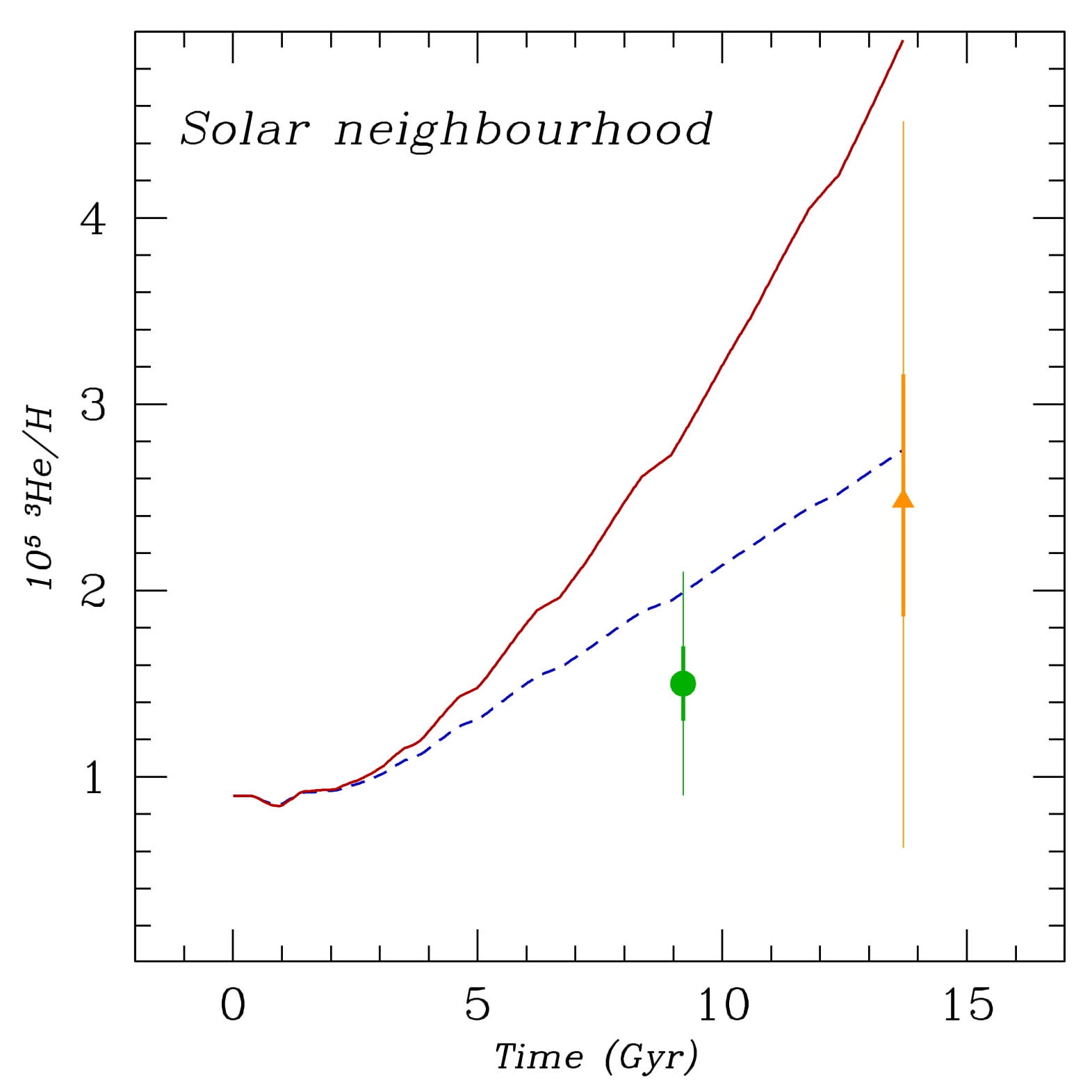Evolution of light Elements in the Milky Way
Context: In light of my non-standard stellar evolution models, I revisited the problem of Galactic evolution of Helium-3, a primordial element produced during the Big Bang and in low-mass stars. This problem, a large production of 3He in the Galaxy and not predicted by classical stellar evolution models, has been known for several decades since the collection of solar wind particles with experience developed by Prof. J. Geiss and his team (Berne), and embarked on the Moon during the Apollo 11 mission
Results: The inclusion of thermohaline mixing in my stellar evolution models shows that the quantity of 3He ejected by low-mass stars during their life are strongly reduced compared to the standard framework predictions. This inclusion provides an elegant solution that reconciles the primordial nucleosynthesis with observations of 3He in the solar wind, in Galactic HII regions, and in planetary nebulae. This study, done in collaboration with specialists of the Galactic chemical evolution, provided me new knowledges and skills on modelling in Galactic chemical evolution, allowing a solution to the long standing "3He problem" on Galactic scale.
In the first article, effects of thermohaline mixing and rotation-induced mixing on the production and destruction of 3He in stars with different initial mass and metallicity, together with new yields, are discussed. In the second article, I present the predictions for the evolution of 3He, 4He, and D in our Galaxy, obtained with the galactic chemical evolution code developed by Dr Matteucci, Dr Chiappini and Dr Romano, and in which I have included new stellar yields taking into account effects of thermohaline mixing and rotation-induced mixing. The inclusion of thermohaline instability in stellar models provides a solution to the long standing "3He problem" on Galactic scale. In addition, stellar models including rotation and thermohaline instability reproduce very well observations of D and 4He in our Galaxy.
 Fig. 1: The evolution of 3He/H with time in the solar neighborhood. Data for the protosolar cloud (green filled circle) and local interstellar medium (LISM, orange filled triangle) are from Geiss & Gloeckler (1998) and Gloeckler & Geiss (1996), respectively. 1-𝛔 and 3-𝛔 error bars are shown with thick and thin lines, respectively. The red lines represent the evolution taking into account the standard stellar models predictions, and the blue line predictions of stellar models including thermohaline instability and rotation-induced mixing (Lagarde et al. 2012b).
Fig. 1: The evolution of 3He/H with time in the solar neighborhood. Data for the protosolar cloud (green filled circle) and local interstellar medium (LISM, orange filled triangle) are from Geiss & Gloeckler (1998) and Gloeckler & Geiss (1996), respectively. 1-𝛔 and 3-𝛔 error bars are shown with thick and thin lines, respectively. The red lines represent the evolution taking into account the standard stellar models predictions, and the blue line predictions of stellar models including thermohaline instability and rotation-induced mixing (Lagarde et al. 2012b).
- “Thermohaline instability and rotation-induced mixing. II - Yields of 3He for low- and intermediate-mass
stars”
Lagarde N., Charbonnel C., Decressin T., Hagelberg J., 2011, A&A, 536, A28.
- “Effects of thermohaline instability and rotation-induced mixing on the evolution of light elements
in the Galaxy : D, 3He, and 4He”
Lagarde N., Romano D., Charbonnel C., Tosi M., Chiappini C., Matteucci F.,
2012, A&A, 542, A62.
